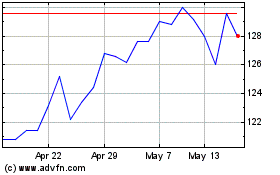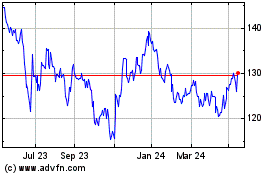International Public Partnership Ld Full Year -33-
March 26 2015 - 3:01AM
UK Regulatory
Liquidity risk is defined as the risk that the Group would
encounter difficulty in meeting obligations associated with
financial liabilities that are settled by delivering cash or
another financial asset. The Group invests in relatively illiquid
investments (mainly non-listed equity and loans). As a closed-ended
investment vehicle there are no automatic redemption of capital
rights. The Group manages liquidity risk by maintaining adequate
cash reserves, banking facilities and reserve borrowing facilities
and by continuously monitoring the forecast and actual cash flows.
Cash flow forecasts assume full availability of underlying
infrastructure to the public sector entities. Failure to maintain
assets available for use or operating in accordance with
pre-determined performance standards may entitle the public sector
to stop (wholly or partially) paying the income that the Group has
projected to receive.
The Directors review the underlying performance of each
investment on a quarterly basis, allowing asset performance to be
monitored. Contractual mechanisms also allow for significant
pass-down of unavailability and performance risk to
sub-contractors.
13. Financial Instruments continued
13.4 Fair value hierarchy
All financial instruments for which fair value is recognised or
disclosed are categorised within the fair value hierarchy,
described as follows, based on the lowest level input that is
significant to the fair value measurement as a whole:
> Level 1 - Quoted market prices in an active market (that
are unadjusted) for identical assets or liabilities
> Level 2 - Valuation techniques (for which the lowest level
input that is significant to the fair value measurement is directly
or indirectly observable)
> Level 3 - Valuation techniques (for which the lowest level
input that is significant to the fair value measurement is
unobservable)
During the period there were no transfers between Level 2 and
Level 3 categories.
Level 1:
The Group has no financial instruments classified as level
1.
Level 2:
This category includes derivative financial instruments such as
interest rate swaps, RPI Swaps and currency forward contracts. As
at 31 December 2014, the Group's only derivative financial
instruments were currency forward contracts amounting to an asset
of GBP2.9 million (2013: asset of GBP3.7 million).
Financial instruments classified as Level 2 have been valued
using models whose inputs are observable in an active market (spot
exchange rates, yield curves, interest rate curves). Valuations
based on observable inputs include financial instruments such as
swaps and forward contracts which are valued using market standard
pricing techniques where all the inputs to the market standard
pricing models are observable.
Level 3:
This category consists of investments in equity and loan
instruments in underlying unconsolidated subsidiary entities which
are classified at fair value through profit or loss. At 31 December
2014, the fair value of financial instruments classified within
Level 3 totalled GBP1,032.9 million (2013: GBP844.4 million).
Financial instruments are classified within Level 3 if their
valuation incorporates significant inputs that are not based on
observable market data (unobservable inputs). A valuation input is
considered observable if it can be directly observed from
transactions in an active market, or if there is compelling
external evidence demonstrating an executable exit price.
Valuation process
Valuations are the responsibility of the Board of Directors. The
valuation of unlisted equity and debt investments is performed on a
quarterly(1) basis by the Investment Adviser and reviewed by the
senior members of the Investment Adviser. The valuations are also
subject to quality assurance procedures performed by the Investment
Adviser. The Investment Adviser verifies the major inputs applied
in the latest valuation by agreeing the information in the
valuation computation to relevant project financial models and
market information. In addition, the accuracy of the computation is
tested. The latest valuation is also compared with the valuations
in the preceding semi-annual and annual reporting periods. The
senior members of the Investment Adviser consider the
appropriateness of the valuation methods and inputs. On a quarterly
basis, after the checks above have been performed, the Investment
Adviser presents the valuation results to the Audit and Risk
Committee. This includes a discussion of the major assumptions used
in the valuations, with an emphasis on the more significant
investments. Any changes in valuation methods and assumptions are
discussed and agreed with the Group's Audit and Risk Committee for
recommendation to the Board.
In addition, any investment acquisitions by the Group from
related parties are also subject to an independent valuation
provided to the Board.
(1) Indicative valuations performed at 31 March and 30 September
where cashflows are updated for asset performance. Macroeconomic
assumptions are updated at 30 June and 31 December.
Valuation methodology
The valuation methodologies used are primarily based on
discounting the underlying investee entities future projected net
cash flows at appropriate discount rates. Valuations are also
reviewed against recent market transactions for similar assets in
comparable markets observed by the Group or Investment Adviser and
adjusted where appropriate.
13. Financial Instruments continued
13.4 Fair value hierarchy continued
Projected net future cash flows
Cash flow forecasts for each underlying investment are generated
through detailed project specific financial models. Financial
models forecast the project related cash flows for the full term of
the underlying service concession. The cash flows included in the
forecasts used to determine fair value are typically fixed under
contracts however there are certain variable cash flows which are
based on management estimation. These models also forecast the
dividend, shareholder loan interest payments, capital repayments
and senior debt repayments (where applicable) expected from the
underlying investments. Key macroeconomic inputs and assumptions
utilised in projecting the Group's net future cash flows
include:
Europe
UK Non UK North America Australia
========================= ================ ================= ======================= ===================
Inflation 2.75% 2.00% 2.00% 2.50%
12.50% -
Long-term tax 20.00% 34.00% 25.00% - 26.50% 30.00%
Foreign exchange rates N/A 1.23 1.84 2.03
Long-term deposit rates 3.50% 3.00% 3.00% 4.50%
========================= ================ ================= ======================= ===================
Discount rate
The discount rate used for valuation of each investment is the
aggregate of the following:
> yield on government bonds with an average life equivalent
to the weighted average concession length of the Group, issued by
the national government for the location of the asset ('government
bond yield');
> a premium to reflect the inherent greater risk in investing
in infrastructure assets over government bonds;
> a further premium to reflect the state of maturity of the
asset with a larger premium applied to immature assets and/or
assets in construction and/or to reflect any current asset specific
or operational issues. Typically this risk premium will reduce over
the life of any asset as an asset matures, its operating
performance becomes more established, and the risks associated with
its future cash flows decrease;
> a further adjustment reflective of market based transaction
valuation evidence for similar assets.
Over the period, the weighted average government bond decreased
by 0.67%. This was offset by a 0.43% increase in the weighted
average project premium to reflect the transactions observed in the
market and the decrease in risk premia relating to construction
assets nearing or that have reached completion. Further details are
provided within the Strategic Report (page 24).
31 December 31 December
Valuation Methodology 2014 2013 Movement
============================= ============ ============ =========
Weighted Average Government
Bond Rate 2.79% 3.46% (0.67%)
Weighted Average Project
Premium 4.69% 4.26% 0.43%
============================= ============ ============ =========
Weighted Average Discount
Rate 7.48% 7.72% (0.24%)
============================= ============ ============ =========
Weighted Average Discount
Rate(1) 7.90% 8.20% (0.30%)
============================= ============ ============ =========
International Public Par... (LSE:INPP)
Historical Stock Chart
From Jun 2024 to Jul 2024

International Public Par... (LSE:INPP)
Historical Stock Chart
From Jul 2023 to Jul 2024
